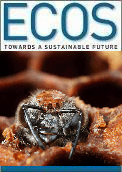
|
Published: 14 May 2012
Homebody habits make coral reef snakes vulnerable
Strong attachments to their home reefs make turtleheaded sea snakes extremely susceptible to disturbances in their local habitats
New research on turtleheaded sea snakes that frequent coral reefs in Australia and nearby New Caledonia has found they are strongly attached to their home reef and rarely venture even a few kilometres to neighbouring reefs.
In a study published in Ecology and Evolution, Researchers from the ARC Centre of Excellence for Coral Reef Studies (CoECRS) and The University of Sydney used genetic ‘fingerprinting’ to show that this behaviour has resulted in significant genetic differentiation in populations of the turtleheaded sea snake living on adjacent reefs. These snakes occur in shallow-water coral reef habitats from the Philippines to the Great Barrier Reef and from New Caledonia to north western Australia.
‘The genetic divergence we found confirms that [these] snakes rarely travel to other locations to mate, regardless of the distance, and means that if one population were to decline or disappear, it is unlikely to be “replenished” by neighbouring snakes, because snakes rarely move between reefs,’ says lead researcher Dr Vimoksalehi Lukoschek from CoECRS and James Cook University.
‘For eight years, sea snakes on two reefs that are adjacent to each other in New Caledonia have been captured, tagged with a microchip device and released,’ says Prof. Rick Shine from the University of Sydney.
‘In almost all instances, the snakes were repeatedly re-captured on the same reef during summers and winters.
‘This finding matches with the genetic dataset, which showed that snakes on their home reefs were more closely related to each other genetically, than they were to snakes on the neighbouring reef. Similar genetic patterns have also been documented for other coral reef sea snake species.’
‘The implications are that coral reef sea snakes are extremely vulnerable to disturbances in their local habitats, which could be caused by human activities or environmental changes,’ says Dr Lukoschek.
‘This is of great concern, given that some Australian populations of turtleheaded and other reef-associated sea snakes have undergone massive declines or local extinctions in recent years, particularly at Ashmore Reef in the Timor Sea, and also on some reefs in the southern Great Barrier Reef.’
While the reasons for this behaviour of sea snakes are still unknown, physical barrier is not one of them, the researchers say.
‘Although movement between reefs by sea snakes can be hindered by deep-water channels, our study sites were in close proximity and connected by shallow-water reef. These sea snakes can swim well and could easily have travelled to the neighbouring reef but they didn’t.
‘It is possible that they don’t move far because they forage exclusively on the eggs of reef fishes that are laid in nests on reefs, so they stick to reefs where they know the locations of those nests. Land snakes have been shown to have memory and the same may also be true for sea snakes. It is also possible that they like to stay close to their “relatives”.’
‘Perhaps because they are snakes, sea snakes have a very low profile on the conservation agenda. Some populations of coral reef sea snakes have declined sharply over the past ten years, but this has gone largely unnoticed and almost no effort has been made to find out why,’ Dr Lukoschek says.
‘We need to pay more attention to these species, particularly because most of the coral reef species that have disappeared from Ashmore Reef are endemic to Australia.’
Source: ARC Centre of Excellence for Coral Reef Studies (CoECRS)




